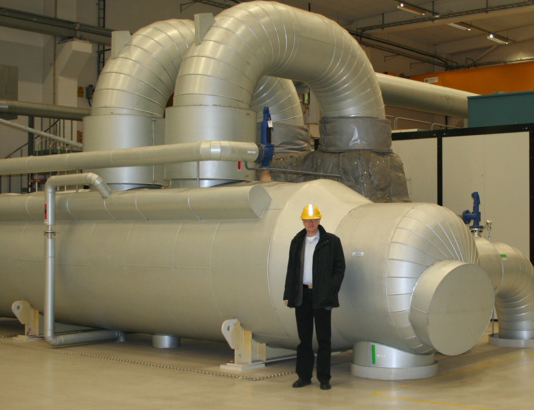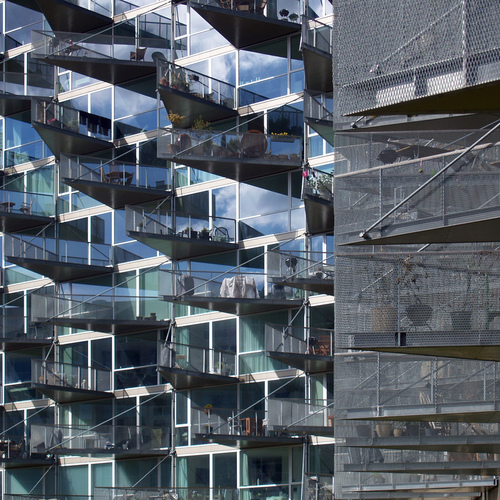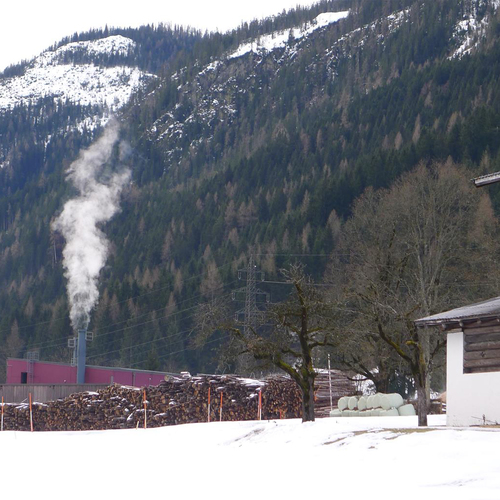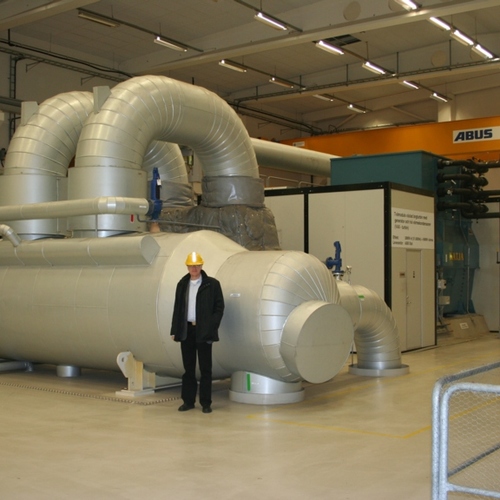
Image Credit: Alex Wilson
Image Credit: Alex Wilson VEAB's CHP plant provides 29,000 customers with electricity and over 6,500 with heat.
Image Credit: Alex Wilson The 10 million gallon heat accumulator at the VEAB plant. This tank of water is heated and then circulated through the district heating system.
Image Credit: Alex Wilson The control room of the VEAB plant.
Image Credit: Alex Wilson During peak operation in the winter, the VEAB CHP plant burns as many as 60 of these tandem-tractor-trailer loads of wood chips per day.
Image Credit: Alex Wilson One of several biodigesters at Växjö's sewage treatment plant.
Image Credit: Alex Wilson Connections for pumping various organic waste streams into the sewage treatment plant.
Image Credit: Alex Wilson Biogas fueling station at the Växjö sewage treatment plant.
Image Credit: Alex Wilson My host's biogas-fueled Volvo at the Växjö sewage treatment plant.
Image Credit: Alex Wilson Low-energy home under construction in Växjö; I believe this was being built to the Passivhaus standard.
Image Credit: Alex Wilson An eight-story timber apartment building under construction in Växjö. The structure and walls are nearly solid wood.
Image Credit: Alex Wilson Wall under construction in the timber highrise. Rigid mineral wool is widely used in Sweden.
Image Credit: Alex Wilson A second timber highrise building further along in construction.
Image Credit: Alex Wilson
My blog last week about Kansas and efforts to outlaw any mention or promotion of sustainability was so depressing (to write as well read) that I needed to find a more uplifting sequel. I needed to remind myself — and readers — that even if some politicians in Kansas don’t want to make the world a better place for their children and grandchildren, that’s not a universal attitude.
There are lots of towns, cities, and countries around the world where planning for the future is a priority and whose sustainability stories are truly inspirational.
I’ll report here on one of those places: Växjö, Sweden — the approximate pronunciation is “VECK’ shuh” — which is often called Europe’s greenest city. Five years ago I had the good fortune to spend a few days in this municipality of 85,000, with an urban core of 60,000.
I learned when I visited that Växjö’s interest in sustainability dates back to the 1960s. At that time, the lakes surrounding the city were heavily polluted — its fish inedible and the water unsafe for swimming. The city decided to do something about that and launched a broad effort to clean up the lakes. The success of those efforts started Växjö on a path to sustainability.
The goal: making the city fossil-fuel-free
A number of city leaders attended and were inspired by the Rio Earth Summit (the United Nations meeting that spawned Agenda 21 — which is being vilified by Glenn Beck and places like Kansas and Alabama). Building on Agenda 21, the City Council of Växjö, which at the time was comprised largely of conservative councilors, adopted a resolution with a goal of becoming fossil-fuel-free by 2030.
The city is now 17 years along in that process — half-way. Whether Växjö will meet its intermediate 2015 target of a 55% reduction in CO2 emissions remains to be seen; the city has so far reduced emissions per resident by 41% (from a 1993 baseline), and the share of renewable energy use is now 60%.
On a per-capita bases, carbon emissions have dropped from about 4,600 kg (10,100 lbs) per year in 1993 to 3,010 kg/yr (6,600 lbs) in 2009. Roughly 68% of current emissions are for transportation.
Biomass heat and power
A big part of Växjö’s high renewable energy fraction comes from a large wood-chip-fueled combined heat and power (CHP) plant. When I visited in 2007, the Sandvik plant of Växjö Energi AB was serving 29,000 customers with electricity and 6,500 customers with heat, including 5,500 single-family homes. District cooling is also being added to the system.
Sandvik is a “thermal following” plant, meaning that its output is governed by heat demands with electricity output “following” that. Heat from the plant is distributed via a 220-mile (350 km) network of insulated hot water pipes. The main supply and return pipes are 31 inches (80 cm) in diameter, with pipes becoming smaller as they branch off.
There are four boilers in the plant, including smaller back-up boilers that can burn oil, but 95% of the energy output is currently from wood chips that are sourced from a 50-mile (80 km) radius of the plant. The largest boiler can produce 38 MW of electricity and 66 MW of thermal energy. (In Europe both electricity and heat are measured in watts, kilowatts, or megawatts; an output of 66 MW of thermal energy is equivalent to 225 million Btus per hour.)
Solar and wind power
While Sweden is not known for its sunshine, new solar-electric systems are going in along with commercial-scale wind turbines. While I didn’t see any of these in Växjö, I did bike beneath some huge wind turbines near Lund, Sweden and was struck by how quiet they were — just a gentle whoosh, whoosh, whoosh of the slowly rotating blades.
Sewage treatment plant producing biogas
The sewage treatment plant in Växjö that I visited was unlike any other I have seen. A big part of the plant was the large biogas digesters. Organic waste is collected from throughout the municipality and anaerobically decomposed in large reactor vessels to produce a methane-rich biogas. This biogas is used to fuel city buses and other municipal vehicles, including the Volvo my host used to drive me around.
With expansions of the biogas facility expected to be completed this year, Växjö should be able to power the city buses plus 500-1,000 cars with biogas. Like the CHP plants I visited in Sweden, Växjö’s sewage treatment plant was immaculate. One could have eaten off the floor.
Energy-efficient buildings
I visited a number of building projects in Sweden, including a single-family detached home and a multi-family apartment complexes being built to the Passivhaus standard — a German rating system with extremely stringent energy conservation requirements.
A large, eight-story, multifamily building that I toured in Växjö was being built almost entirely of wood. Sweden, like the U.S., is rich in forest resources, and Linnaeus University has a research program focusing on timber construction practices. This focus is motivated in part by the goal of reducing the embodied energy of building materials — part of the goal of becoming fossil-fuel-free.
The transportation challenge
As Växjö works toward its goal of becoming fossil-fuel-free by 2030, the challenge of transportation is becoming more and more significant. The city has done a good job at promoting public transit and bicycle paths, but recognizes that transportation will be the biggest hurdle in meeting it’s 2030 goal.
Ethanol-powered vehicles and a growing focus on electric vehicles will help in achieving those goals.
Local food
Växjö has a goal of increasing local food production from 13% in 2009 to 20% in 2015, with ecological (organic) agriculture growing from 13% to 30% during that same time period.
As we read about places like Kansas and Alabama where sustainability planning is seen as some sort of foreign attack on U.S. sovereignty, it is great to follow the progress in places like Växjö, where sustainability has been taken to heart and is being acted on.
It’s worth noting that the emphasis on energy reductions and sustainability doesn’t seem to be hurting Sweden’s standard of living. By most metrics (life expectancy, infant mortality, physical fitness, leisure time, education, ownership of second homes), Sweden is well ahead of the U.S.
Alex is founder of BuildingGreen, Inc. and executive editor of Environmental Building News. In 2012 he founded the Resilient Design Institute. To keep up with Alex’s latest articles and musings, you can sign up for his Twitter feed.
Weekly Newsletter
Get building science and energy efficiency advice, plus special offers, in your inbox.















3 Comments
One thing i notice from
One thing i notice from chatting with "nordics" euro residents is that they are usually
much more "societal" and conscient about future and impact of our lives.
Most of them are usually ok with making large compromises to achieve large scale green goals,
which is something i have yet to see here.
There is also a large difference in values from these contries VS usa/canada ,
where most here are after "looks".
Very interesting article mr Wilson, please keep up looking for similar cities/countries to share with us!
European RE district heating
http://solarthermalworld.org/content/denmark-construction-start-dronninglunds-solar-district-heating-plant
solar thermal...
According to PlanEnergi, the cost for the solar collectors - including internal piping and the foundation – will be approximately 155 EUR/m².
Hein, after having passed the last 2 months discussing and calculating solar thermal panels
as a future product i would've like to manufacture
( still discussing with various manuf. )
I have to a admit that i am pushing away solar thermal in favor of PV as Martin had pointed out in his Solar thermal is DEAD blog entry...
even at the very low cost of 155$EURO /m2
at their latitude, the only incentive to go on using ST i can see is that they have local manufacturers and that the money they are investing on the panels will get injected back in their own country,
not in foreign affairs .. that is a good point..but still
usual yield in Denmark for a very efficient ST are in the ~500kwh /year
then losses of systems factored in..
then u need to cut that in 3-4 to compare with the current average COP of HP water heater and space heating ...the fact that electricity gets used even during summer where 100% of the ST generated heat might not ...standby losses
Log in or create an account to post a comment.
Sign up Log in